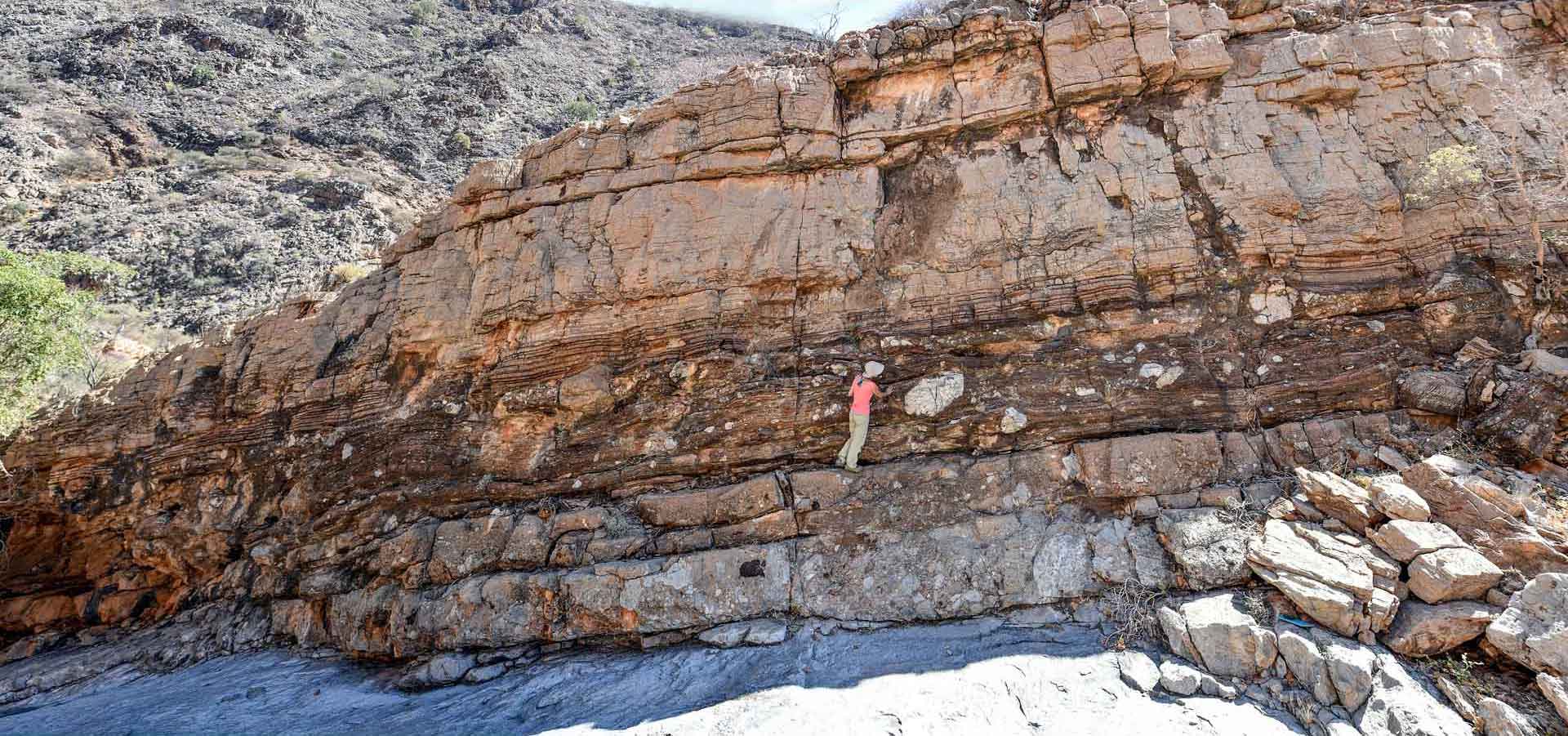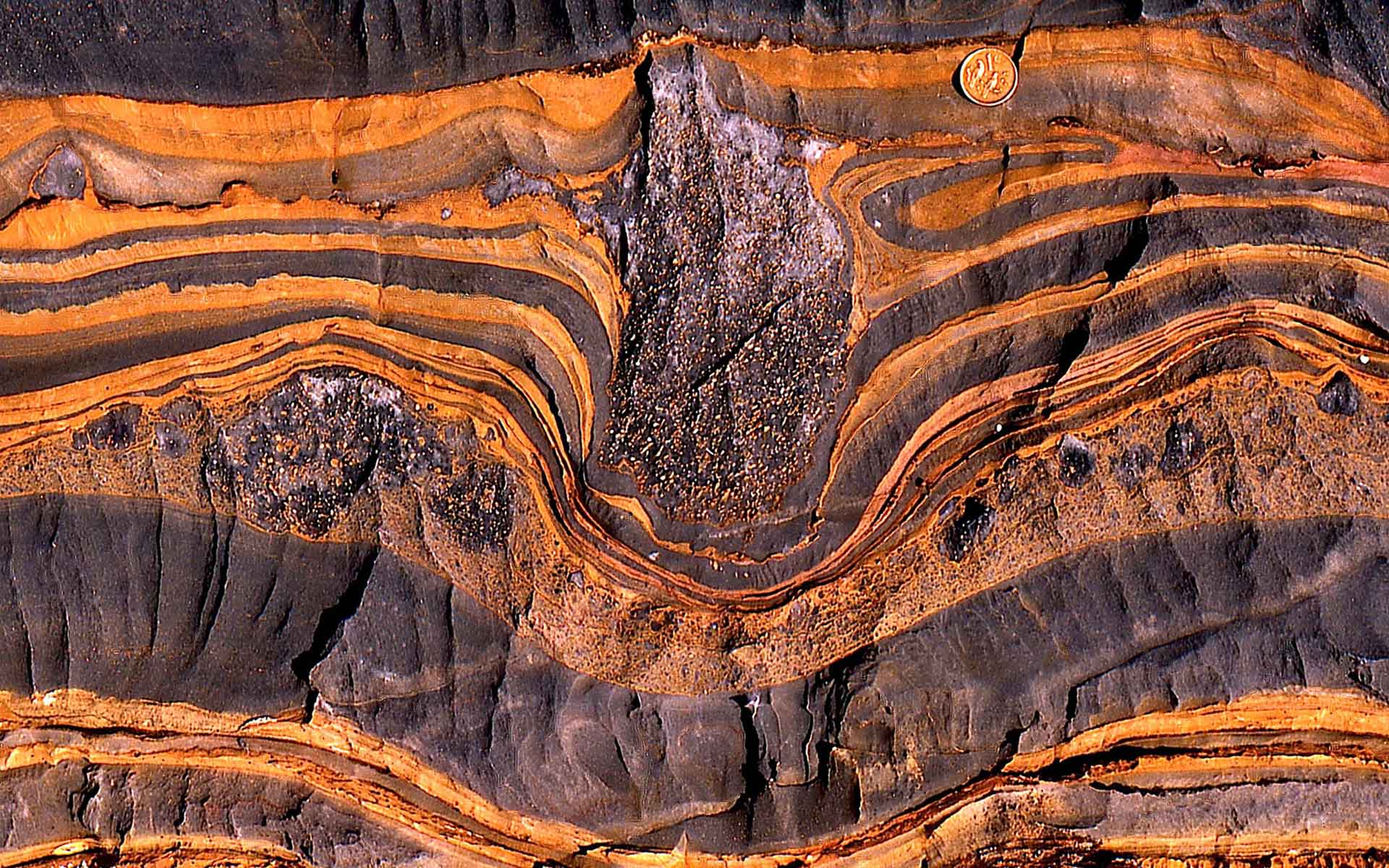
Abrupt contact between terminal ice-rafted carbonate debris and postglacial cap dolomite, western terminus of Fransfontein Ridge near Narachaams se Pos. (Photo: Luis Carcavilla).
Geological Period
Upper Cryogenian − Early Ediacaran
Main geological interest
Stratigraphy and sedimentology
Location
Fransfontein Ridge Kunene Region, Namibia.
20°11’51.0″S, 15°01’11.0″E
Abrupt contact between terminal ice-rafted carbonate debris and postglacial cap dolomite, western terminus of Fransfontein Ridge near Narachaams se Pos. (Photo: Luis Carcavilla).
Stratigraphic record of a snowball Earth from onset to termination on the foreslope of a warmwater marine carbonate platform.
During snowball Earth, ice sheets covered most continents causing large sea- level falls. This, combined with thick shelf ice, shifted sediment accumulations from continental shelves to slopes. Slopes were relatively narrow and the probability of fortuitous exposure 635 million years later is low. Snowball Earths are rare, occupying only 1.5% of Earth history. Evidence of glaciated carbonate platforms is critical because, due to saturation chemistry, they represent the warmest parts of the ocean. If they were glaciated, colder regions were frozen also. This was the first line of evidence for snowball Earth, much later supported by many independent lines of evidence.
- Geological description
On Fransfontein Ridge, the margin of an ancient warmwater marine carbonate platform is exposed in oblique cross-section, allowing its construction to be examined in detail (Hoffman et al., 2021). During its growth, Earth experienced a 6−16 million-year panglacial epoch when the world ocean was covered by an unbroken ice shelf hundreds of metres thick (Hoffman et al., 2017). A grounded ice sheet formed on the carbonate platform, fed by sublimation off the tropical ice shelf. Its motion was slow, because cold air holds little moisture, but its longevity caused cumulative glacial erosion and deposition that reshaped the platform margin. Headwall erosion at the top of the foreslope produced a bench 0.4 km vertically below the top of the platform (Hoffman, 2022). On the slope below the bench is a composite moraine, ≤0.6 km thick, marking the grounding zone of the ice shelf (Domack and Hoffman, 2011). The moraine rests on a glacial erosion surface to ≥0.6 km paleodepth below the bench, reflecting initial ice-shelf thickness and sea-level fall. During snowball Earth meltdown, the entire platform and margin were covered by a ‘cap dolomite’ (Hoffman, 2011) that occurs globally and defines the base of the Ediacaran Period.
- Scientific research and tradition
Stratigraphic, sedimentologic, isotopic and radiometric evidence from Fransfontein Ridge was critical in the framing and broad acceptance of the snowball Earth hypothesis for Cryogenian glaciations (Hoffman et al., 1998). Stratigraphic sections logged over the past 30 years are currently being stitched together with the aid of high-resolution dronebased imagery.
- Reference
Domack, E.W. and Hoffman, P.F. (2011) ‘An ice grounding-line wedge from the Ghaub glaciation (635 Ma) on the distal foreslope of the Otavi carbonate platform, Namibia, and its bearing on the snowball Earth hypothesis’, GSA Bulletin, 123(7–8), pp. 1448–1477. Available at: https://doi.org/10.1130/B30217.1.
Hoffman, P.F. et al. (1998) ‘A Neoproterozoic Snowball Earth’, Science, 281(5381), pp. 1342–1346. Available at: https://doi.org/10.1126/science.281.5381.1342.
Hoffman, P.F. (2011) ‘Strange bedfellows: glacial diamictite and cap carbonate from the Marinoan (635 Ma) glaciation in Namibia’, Sedimentology, 58(1), pp. 57–119. Available at: https://doi.org/10.1111/j.1365-3091.2010.01206.x.
Hoffman, P.F. et al. (2017) ‘Snowball Earth climate dynamics and Cryogenian geology-geobiology’, Science Advances, 3(11), p. e1600983. Available at: https://doi.org/10.1126/sciadv.1600983.
Hoffman, P.F. et al. (2021) ‘Snowballs in Africa: sectioning a long-lived Neoproterozoic carbonate platform and its bathyal foreslope (NW Namibia)’, Earth-Science Reviews, 219, p. 103616. Available at: https://doi.org/10.1016/j.earscirev.2021.103616.
Hoffman, P.F. (2022) ‘Glacial erosion on snowball Earth: testing for bias in flux balance, geographic setting, and tectonic regime’, Canadian Journal of Earth Sciences [Preprint]. Available at: https://doi.org/10.1139/cjes-2022-0004.
- Author(s)
Paul F. Hoffman
University of Victoria, Canada
Daniel J. Condon
British Geological Survey, Keyworth, UK
Eugene W. Domack
University of South Florida, USA (†deceased)
Galen P. Halverson
McGill University, Montreal, Canada
Karl-Heinz Hoffmann
Private Consultant, Windhoek, Namibia
Francis A. Macdonald
University of California, Santa Barbara, USA
Anthony R. Prave
University of St Andrews, Scotland, UK
Ute M. Schreiber
Geological Survey of Namibia, Windhoek, Namibia
Roger Swart
Private Consultant, Windhoek, Namibia
Adrian Tasistro-Hart
University of California, Santa Barbara, USA
Absai Vatuva
University of Namibia, Keetmanshoop, Namibia


